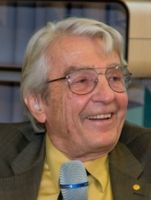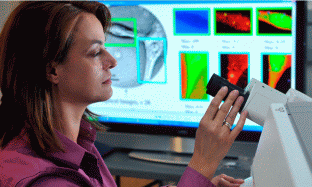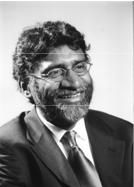

Ivar Giaever
Emeritus Professor at Rensselaer Polytechnic Institute, Troy, U.S.A.
Professor at large, University of Oslo, Norway
From Quantum Physics to Biotechnology: Reflections and Advice
Prof. Giaever is most famous for his experimental discoveries regarding tunneling phenomena in superconductors. For this work, he received in 1973 the Nobel Prize in Physics. Prof. Giaever's research later in his career was mainly in the field of biophysics.
He also worked with Prof. Ugelstad, the inventor of the Dynabeads.

Gustav Steinhoff
Professor and Director, Clinic of Cardiac Surgery, University of Rostock, Germany
Enhanced Thoracic Gene Delivery by Magnetic Nanobead-Mediated Vector
Prof. Steinhoff is at the forefront of delivering stem cells to damaged hearts and investigating the potential of such therapies for therapy. With his team, he is doing this research with the help of magnetic particles and magnetic fields that lead to the localized gene expression in distinct parts of the heart of mice.
 Shan X Wang
Shan X Wang
Professor of Materials Science and Engineering, and jointly of Electrical Engineering, Stanford University, Stanford, California, U.S.A.
Director, Center for Magnetic Nanotechnology, Stanford University
Magneto-Nano Chips for Biomedical Diagnostics
Prof. Wang’s group is developing a magneto-nano sensor protein chip based on magnetic nanoparticles and giant magnetoresistive (GMR) spin valve sensor arrays that allow rapid conversion of discrete biomolecule binding events into electrical signals in real time and in multiplex. The magneto-nano sensor chip is shown to recognize and quantitate multiple protein tumor markers and relevant protein profiles in mouse and human serum samples with unprecedented sensitivity and specificity, with a detection limit of sub-femtomolar concentrations and with a dynamic range of ≥6 logs. These magneto-nano sensors function by exhibiting significant resistance changes which are induced solely by external magnetic fields and are therefore insensitive to solution conditions such as buffers, pH or ionic strength. The technology is thus relatively insensitive to so called matrix effect and operates effectively in a wide variety of biological fluids including serum, plasma, PBS, cell lysate, urine and saliva.
Elena Rozhkova
 Scientist, Argonne National Laboratory, Argonne, IL, U.S.A.
Scientist, Argonne National Laboratory, Argonne, IL, U.S.A.
Biofunctionalized Magnetic-Vortex Microdiscs for Biomechanical Cell Actuation
Dr. Rozhkova’s research interests are at the intersection of bio(in)organic and biological chemistry, functional materials and life sciences. Current efforts focus on design of advanced nanoscale hybrid materials for molecular signal transduction, cell actuation and probing of cellular bioenergetic processes. Most recently, Dr. Rozhkova made lithographically defined magnetic microdiscs that possess a spin-vortex ground state. When an alternating magnetic field is applied the microdisc vortices shift, creating an oscillation, which transmits a mechanical force to the cellular machinery. In cancer cells, the spin-vortex-mediated stimulus created two dramatic effects: compromised integrity of the cellular membrane, and initiation of programmed cell death, already at very weak (<100 Oe) magnetic fields of a frequency of a few tens of Hz, applied for a duration of only 10 min.
Christian Plank
Adjunct Professor, Technical University Munich, Institute of Experimental Oncology and Therapy Research
Magnetofection – magnetically enhanced nucleic acid delivery, from research tool towards clinical application
Christian Plank’s group is developing systems for localized nucleic acid delivery. Equipping these systems with magnetic nanoparticles allows localizing delivery and boosting its efficiency by magnetic force. This form of magnetic drug targeting, also known in the literature as “Magnetofection”, is used by researchers worldwide for nonviral and viral nucleic acid delivery.
An extension of magnetic targeting concepts is their combination with modules for triggered drug release. In this context, the Plank group develops thermosensitive magnetic liposomes and magnetic microbubbles. With the latter, localized nucleic acid delivery can be triggered by ultrasound. This has been used advantageously for tissue regeneration in a rat skin-flap model which is relevant in reconstructive surgery.
Furthest advanced towards clinical application is a nanomagnetic genetic tumor vaccine consisting of plasmid DNA, bound to magnetic nanoparticles, encoding a cytokine. When applied intratumorally in animal patients (cats) suffering from fibrosarcoma, the most frequent skin tumor in cats, this vaccine prolongs the recurrence-free survival time from 270 to more than 1000 days.
Kannan Krishnan
Professor of Materials Science and Adjunct Professor of Physics, University of Washington, Seattle, WA, U.S.A.
Tutorial on Magnetic Things We All Should Know: What is Nano? What Formulas Should We Know By Heart? What Magnetic Properties Are Still Surprising?
As the Distinguished Lecturer chosen for 2009 by the IEEE Magnetics Society, Prof. Krishnan will teach us in 3 half-hour lectures a few things that we all once knew but might have forgotten. Prof. Krishnan ’s inter-disciplinary research interests are in magnetic nanostructures and thin film heterostructures, biomedical nanomagnetics, oxide spin electronics, advanced materials characterization and structure-property correlations at relevant length scales. All the projects are vertically integrated from the underlying science to their engineering (information storage, MEMS, magnetoelectronic devices) and biomedical (diagnostics, imaging and therapeutics) applications including giant magnetoresistance (GMR).


 Abstracts
Abstracts